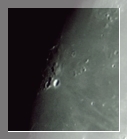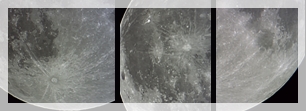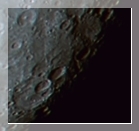
Some Must See Lunar Regions as Accessible to A Small Telescope
The list below is decribing some must-to-see lunar regions as accessible to a small telescope like, for example a 4½" Newtonian, or a small refractor. Those landscapes are categorized by decreasing order of interest. That interest is subjectively determined by the author of that tutorial. Indications of visibility also allow to sort those locations by epoch of the Moon (let's recall that a lunar landscape may be observed, first, when the Moon is waxing from new to full -which is from twilight to early night- and then, when the Moon is waning from full to new -which is from early night to dawn). To help into the discovery of those lunar landscapes, you will usefully use our Moon's maps
-
Plato, Pico
- visibility: from First Quarter to waxing gibbous Moon, then from Last Quarter to waning crescent
Plato is a fine crater, with a diameter about 62 miles. It is dating back to the Imbrian lunar geological era, or between 3.8 and 3.2 billion years. Clearly cut walls, at 3,200 ft in height, are delineating a plane and dark floor (where small craters are theoretically visible). The walls also are often providing accute shadows. The crater's name is a hommage to the 5th century B.C. Greek philosopher Plato. Pico, or mons Pico, is a prominent peak which stands, South of Plato, in the northeastern Mare Imbrium. Much fine view! In the area, you may also see other isolated peaks or moutains, or small craters, which provides for fine views against the background of the flat floor of the see. Undulations too are seen
- Ptolemaeus, Alphonsus, Arzachel
- visibility: either side of First, and then Last Quarter
those three craters, which are aligned North-South, trois cratères qui sont alignés du Nord au Sud, Ptolemaeus, Alphonsus, and Arzachel, are a classical lunar view. That alignment allow them to well take to profit the terminator either side the First, or the Last Quarter. The craters also stage according to their age, from the oldest Ptolemaeus (4.5 to 3.9 billion years) to the youngest Arzachel (3.8 billion years) as Alphonsus is about 3.9 billion years. And the same for their size, with 96, 73 and 61 miles for Ptolemaeus, Alphonsus, and Arzachel respectively. Ptolemaeus was thus named by reference to the 2nd century A.D. Geek astronomer and geographer as its floor is flat, with a sole crater well visible. Alphonsus was named after king Alphonsus X of Casilla, or Alphonsus the Wise, who authored the Alphonsine Tables; it features a less united floor but it possesses a fine central peak. Arzachel, named from 11th century A.D. Arab, Toledan astronomer Al Zarqali) is featuring a central peak, a crater and fine terraced walls. The West of the area is opening upon the Mare Cognitum and Mare Nubium as the East upon a vast region of craters of varied sizes
- Palus Somni
- visibility: from the New Moon to waxing crescent, then from Full to waning gibbous Moon
Palus Somni is a interesting area which is located between Mare Crisium and Mare Tranquillitatis. It displays a coloration different from both as that difference is clearly delimited Nord. Palus Somni otherwise is a zone of diverses, few important reliefs and of some craters. Sinus Concordiae is seen South as, more South still, you will check Taruntius Crater, at 35 miles and few elevated
- Sinus Iridum
- visibility: from waxing gibbous Moon to Full, then from waning crescent to New Moon
Sinus Iridum is a must see of lunar landscapes. That bay is a large crater which has been submerged at the time when Mare Imbrium's lava expanded and the northern parts of its wall only kept extant, as limited southwest by the promontory of Heraclides and northeast the one of Laplace. Helicon and Le Verrier craters, at each about some 12 miles in diameter, are also interesting, South of Laplace. Sharp Crater is seen on the slopes of Jura Mounts as Bianchini Crater is more East. The region of that bay also is featuring undulations, the most important of those is the dorsal of Heim as it is found through the Herschel and Heis craters
- Theophilus, Cyrillus, Catharina
- visibility: from waxing crescent to First Quarter, then from waning gibbous Moon to Last Quarter
here is another famed trio of lunar craters which are displaying in a arc along the western coast of Mare Nectaris (that mare is considered a bay of Mare Tranquillitatis). Those three craters are about 62 miles in diameter as Cyrillus and Catharina are the oldest. Younger Theophilus is featuring a well visible central mountain as Cyrillus, albeit featuring also a peak, is clearly eroded and as Catharina it obliterated. Fracastorius Crater is seen South of Mare Nectaris. The three craters are lying by about the same lunar latitude than Ptolemaeus, Alphonsus and Arzachel but on the other side of the craterized area which marks the East of their area. Theophilus was a 4th century A.D. Greek philosopher as Cyrillus is named after St. Cyrillus, a 5th century theologian, and Catharina is Ste Catharina of Alexandria, a Greek martyr about 307 A.D.
 | Theophilus, Cyrillus, Catharina craters as images through 8x21 binoculars and a compact digital camera! picture site 'Amateur Astronomy' |
- The Alpine Valley
- visibility: either side of First, and then Last Quarter
The Alpine Valley dates back to the Imbrian geological era, between 3.8 and 3.2 billion years. It is a tectonic fault which is running from the southwest to the northeast, with a length 81 miles and a width 7. Its cuts the whole montaneous area which lies East of Platon, as those mountains have been named the Alps (even the Mont Blanc is seen by the mouth of the valley, northeast of the Mare Imbrium)
- Apennine Mounts
- visibility: from waxing crescent to First Quarter, then from waning gibbous Moon to Last Quarter
A whole, vast chain of mountains is stretching from the shores of Mare Serenitatis down to Eratosthenes Crater. They are featuring a sharp northwestern slop as their southeastern one is a vast piemont. They are reaching a altitude of 18,000 ft at the Mount Huygens. They are constituted, from the northeast to the southwest of Mount Hadley, Mount Bradley, Mount Huygens, Mount Ampere, the Apennine Mounts and Mount Wolff. Conon Crater is seen too as its name refers to a Greek mathematician and astronomer, a friend to Archimedes, who created the Coma Berenices constellation
- Aristoteles, Eudoxus and Caucasus Mounts
- visibility: from waxing crescent to First Quarter, then from waning gibbous Moon to Last Quarter
Here is a sequel of sort to the mountaneous region of the Apennine Mounts. That new chain of mountains is taking northeast of Mare Serenitatis as it is sharp-sloped either side and constituted mostly of Caucasus Mounts. Two important craters are seen North, with Eudoxus and Aristoteles. Eudoxe was named from 4th century B.C. Greek astronomer as it has a diameter of 42 miles. The impression of depth it gives might well be due to that it is encased into a area of middle-sized mountains. Aristoteles is the famed 4th century B.C. Greek philosopher, the preceptor to Alexander the Great as its larger, at 55 miles. He also possesses elevated walls. Both craters are featuring central mountains
- Copernicus Crater
- visibility: from First Quarter to waxing gibbous Moon, then from Last Quarter to waning crescent
Copernicus Crater is one of the most reknown lunar craters. As located South of Carpatus Mounts and East of Oceanus Procellarum, it represents a most typical lunar crater type, with terraced walls, a central peak, a ejecta area as, by the Full Moon, a vast system of bright rays is visible and emanating from the crater. Copernicus had a diameter of 58 miles as it is a young crater, of about 800 million years. Crater central peaks are formed as the Moon's crust rebounds after the tremendous stress of an impact is released. Ray systems of lunar craters as young as Copernicus are due to that ejecta are reaching to far distances during the impact; those ejecta moreover, are featuring a high albedo thus reflectance, which gives to the rays their luminous aspect. Such that aspect is mostly seen by the Full Moon; the rays of Tycho Crater, a crater located South of the Moon are also seen by that time. You will also easily check around Copernicus Crater a closer area of ejecta which also is a characteristic. That is where most of the material ejected by the impact settled. Such a area is generally lying within 1 crater diameter.
- Aristarchus, Schröter Valley
- visibility: from waxing gibbous Moon to Full, then from waning crescent to New Moon
here we have a other classics of lunar landscapes as it will however be more easily observed with more important telescopes. Aristarchus Crater owns its name ot its namesake 3rd century B.C. Greek astronomer, has a diameter of 25 miles and is relatively profound. The Herodotus Crater, from the 5th century A.D. Greek historian Herodotus, is more submerged. Both are at the starting point of a long sinuous fault which is named the Schröter Valley. It is 4 to 6-mile wide. The aspect of the area lets think that some volcanic activity occurred there. Sinuous riles on the Moon look like they are resulting from Moon's volcanism. Neighbouring plains and formations are also of interest. Schröeter was a 18th century German astronomer, a specialist of lunar riles and dorsals
 | As the Schröter Valley proper is barely seen out of Moon's shadow at the center left of that image, Herodotus and Aristarchus craters are well seen below as are the Mts Harbinger right. That view taken with a small 60/700 refractor! picture site 'Amateur Astronomy' |
- Tycho
- visibility: the ray system of Tycho is best seen by Full Moon
A very young crater, at 100 million years, a diameter 52 miles and a average depth below the rime of 15,700ft, Tycho Crater, in the highlands region of the Moon's southern hemisphere is a famed feature mostly known for its bright radiating streaks system extending far away. Such ejecta rays, which are also extant at some other large lunar craters, like Copernicus, for example, are extensive, high-reflectance ejecta (which are the materials ejected by the impact which generated the crater) extending across nearby mare and
overlap ejecta from other craters. Tycho also features a 8,000-ft central peak. Such craters with ray systems are best seen at the moment of Full Moon
 | Tycho Crater and its ray system (left), Copernicus and Kepler's (center), and a region of craters with rays in the area of Stevinus Crater (right) (all pictures imaged through a small refractor). picture site 'Amateur Astronomy' |
- Rupes Recta
- visibility: from First Quarter to waxing gibbous Moon, then from Last Quarter to waning crescent
Rupes Recta, or the Straight Wall, is a other classics on the Moon. It is found southeast of Mare Nubium and southwest of the Ptolemaeus, Alphonsus and Arzachel craters. Birt Crater is found nearby. The Straight Wall is a fault with a length 69 miles as its height is about 1,000 feet above the surrounding lunar plain. In appropriate lighting conditions one may can check that the slope is covered with a bright material. The aspect of the Straight Wall of course varies function of the angle at which sunlight is illuminating. Despite of how it looks sharp, the slope of the fault is just at between 30 and 40 degrees
- Mare Crisium
- visibility: from the New Moon to waxing crescent, then from Full to waning gibbous Moon
Mare Crisium is that well known, circular lunar mare which is lying near the eastern limb of the Moon. Lunar maria are gigantic impact basins with filled with lava flows, which later solidified. Such large impacts date back to between 3.8 and 3.9 billion years. As far as Mare Crisium is concerned, the result was that large basin which is spanning 460 miles wide with the floor approximately 1.1 miles 'lunar datum' -which is sea level at Earth, while the outer rim is about 2.1 miles above that. Peirce and Picard craters are seen West. The large crater punctuated with smaller ones, North, is Cleomedes Crater, at 79 miles in diameter. He was named from a 2nd century B.C. Greek astronomer
- Kepler Crater
- visibility: from waxing gibbous Moon to Full, then from waning crescent to New Moon
Kepler Crater is a rayed crater, with a relatively small size of 19 miles in diameter as it is lying in Oceanus Procellarum, West of Copernicus Crater. He dates back to the same era than that. It is owing its name to Kepler, the famed, 17th century German astronomer, the aid to Danish Tycho Brahe, who determined the three laws of the planets' motion. The vicinity is interesting too. The relatively submerged crater South is Encke
- Erathostenes
- visibility: from First Quarter to waxing gibbous Moon, then from Last Quarter to waning crescent
Large Erathostenes Crater is terminating the mountain chain which is along the southeastern shores of Mare Imbrium. With a diameter 36 miles, he was named from a 3rd century B.C. Greek mathematician and astronomer, one of the chiefs of the Library of Alexandria, who was the first to measure the circumference of the Earth. It is a fine crater with terraced walls and a central peak. The mountaneous area, South, is unnamed. The plain, southeast, is Sinus Aestuum
- Rheita Valley
- visibility: from the New Moon to waxing crescent, then from Full to waning gibbous Moon
Rheita Valley is a relief formation which results from the strong, linear imbrication of several craters. It features a total length of 311 miles with a width 19. The Rheita Crater is lying northeast of the valley as Young D Crater is southwest. Rheita was a 17th century Czech astronomer who built his telescope to Kepler. The area is a one of craters and mountains. Such highland regions are lunar crust areas battered by crater impacts as they are lying where no maria are extant. They are made of a rock called anorthosite which is rich in calcium and aluminum, which provides for their bright aspect compared to the maria darker areas (which are made of volcanic basalt and abundant in iron and magnesium)
 | "Rheita Valley is the linear feature heading to the dark limb of the Moon, at picture's center. Rheita Valley is imaged here through a small refractor! picture site 'Amateur Astronomy' |
Interested Into Where the Apollo Lunar Mission Sites Stand?
Between the year 1969 and late 1972, the Apollo program managed to land 6 manned missions on our Moon. Those sites are not observable from the Earth as the following list will however give you some idea about where they are located. Varied lunar cartography softwares are allowing to more accurately define those sites:
- the Apollo 11 mission site -the first of the Apollo program to land on Moon, is lying South of the Mare Tranquillitatis, slightly southeast of the Sabine Crater, by three diameter of it
- the Apollo 12 landing site is southeast of the second most important crater southwest of Copernicus Crater, which is Lansberg Crater, and by some two and half diameters of that crater
- the Apollo 13 mission never could land on the Moon for cause of a explosion en route
- the Apollo 14 mission site is somewhat more East from the Apollo 12 one, by about the same latitude, North of the submerged Fra Mauro Crater
- the landing area of the Apollo 15 mission is lying about the foothills of Mount Hardley
- the Apollo 16 mission site is located barely higher in latitude that the northern ridge of Theophilus Crater, by some three diameters West, northeast of Dollond Crater
- the Apollo 17 mission site -the last mission of the Apollo program- is located in the area of mountains southeast of Mare Serenitatis, in the neigbourhood of Littrow Crater, South of it, by barely a diameter
Website Manager: G. Guichard, site 'Amateur Astronomy,' http://stars5.6te.net. Page Editor: G. Guichard. last edited: 3/5/2015. contact us at ggwebsites@outlook.com




